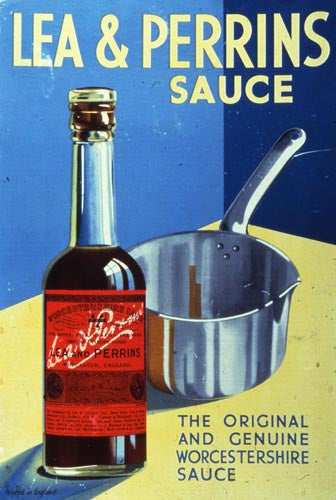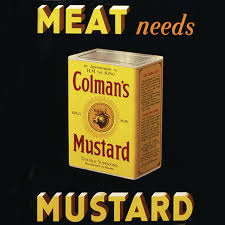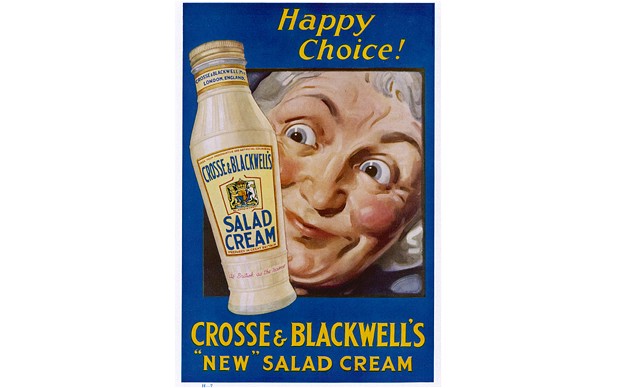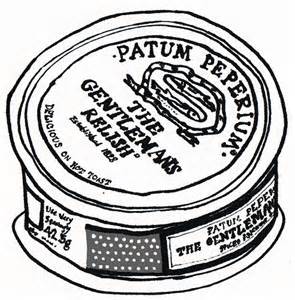Us Brits are known to love a condiment or two with every meal, everyone has a favourite and every dish has its best friend e.g. HP and a bacon sandwich, tartar sauce with fish and chips, mustard with a roast maybe?
Personally I'm a huge fan of HP and it's my go to condiment! I LOVE HP sauce as much as I LOVE tea! So much so that in my university days my friends made me a ‘Happy Birthday’ t-shirt with a bottle of HP sauce on it because I’m such a fan!
Here's a look at the fascinating origins of a few favourites.
HP Brown Sauce

This zingy concoction is the UK's No. 1 brown sauce choice and has been adding oomph to savoury dishes, hot and cold for over 100 years (also great as an ingredient in soups or stews!). In 1899 Nottingham grocer Frederick Gibson Garton invented the original recipe of a malt vinegar base, blended with tomato, dates, tamarind extract, sweetener and spices. 6 years later Garton registered the name ‘HP Sauce’ which stands for 'Houses of Parliament' cannily claiming that Parliament had started serving it and he decorated his bottles with the now-familiar lithograph of the House of Commons. The recipe was later sold for the sum of £150 to settle a debt that Garton had with vinegar manufacturer Edwin Samson Moore, who launched what we know and love today as HP Sauce.
A whopping 28 million bottles are consumed in a year and if the bottles were stacked on top of each other, they would reach the same height as 6,189 Houses of Parliament!
As the popularity of HP has grown, so has the range; Back in 1969 HP Fruity was launched as a milder version of traditional HP with blended fruits and spices giving a bit more tang. For the more health conscious HP lovers HP Reduced Salt and Sugar, with 25% less salt and 30% less sugar was added along with HP BBQ and HP Pepper to complete a range of sauces to suit everyone's taste.
For many years the HP headquarters was a factory in Aston, Birmingham, once bisected by the A38(M) motorway they had a pipeline, carrying vinegar over the motorway from the Top Yard to the main Tower Road factory site. The Top Yard site was subsequently closed, and vinegar was not brewed on the Aston site during the last few years of production there.
HP may not be made here in the UK any more – production moved to Holland (which caused a bit of an outcry at the time) – but HP remains wholly British in spirit and the brown stuff will always remain the best complement to one of our greatest offerings: the full English breakfast.
Worcestershire Sauce

As the name suggests the story of Lea & Perrins famous Worcestershire Sauce (shortened to Worcester Sauce) begins in the early 1800s, in the county of Worcester, UK. Lord Sandys, a nobleman of the area, was eager to duplicate a recipe he'd acquired on his travels in Bengal and so on his request, two chemists, John Lea and William Perrins, made up the first batch of the sauce.
The initial results were not quite what Lea & Perrins had desired so the rather unpalatable mixture was left in a jar and banished in their cellar to gather dust. A few years later, they came across the jar and decided to taste the contents again. To their joy and surprise the aging and fermenting process had turned their creation into a delicious flavoursome savoury sauce. The exact recipe remains top secret and to protect the sauce from imitators, the famous Lea & Perrins signature was put on the label of the bottle, as it appears today.
Mr. Lea and Mr. Perrins began bottling their special blend and in just a few short years it was known and coveted in kitchens throughout Europe.
In 1839, John Duncan, a New York entrepreneur, ordered a small quantity of the sauce and in just a few short years Duncan was importing large shipments to keep up with demand. Over 175 years later Lea & Perrins sauce remains a worldwide favourite and is now available in over 75 countries. We Brits use it to make the ultimate cheese on toast, in Spain it's used in salads, it’s loved as a dipping sauce, stir-fry sauce and beef marinade in Hong Kong and in Canada and the USA it's known as the "Burger Booster" used to enhance beef burger recipes. This British loved sauce is part of time-honoured family food traditions worldwide.
Colman’s Mustard

Jeremiah Colman started his mustard and flour business in 1814 in Norfolk, a family business, Jeremiah and his wife cared deeply about family values and looked after their employees like their own. They even established a school for the children of all their employees, company housing & sick benefits. In 1858, Jeremiah Colman’s great-nephew Jeremiah James Colman established the production factory in Norwich which still exists in the same spot today.
Around 1855, the bull’s head logo, now synonymous with Colman’s was adopted as one of the firm’s trademarks and has since been a recognisable hallmark.
The mustard making process remains much the same since day one, 60% of the seeds are sourced locally and still undergo a thorough sampling, cleaning, and drying process using original wooden sieving equipment from the 1950s. Not only has the process and the factory remained largely the same but some of the families who farm the mustard seeds have remained the same too with some 5th generation employees.
Colman’s gained Royal approval in 1866 with the granting of Special Warrant as ‘Manufactures to Her Majesty the Queen Victoria’, followed in 1868 by a Warrant as Purveyors to HRH The Prince of Wales.
Colman’s became part of Unilever’s Van Den Bergh Foods in 1995 but remains a great British favourite, put a fiery helping on your roast, stir generously into your gravy or lash onto a meat sandwich.
Salad Cream

The pale yellow creamy sauce known as Salad Cream was introduced to the UK in the 1920s, used as a salad dressing and a sandwich spread. Once so nationally loved it was known as "the English sauce"! It’s also been known as the poor person’s mayonnaise as due to the high cost of ingredients during rationing time and with a flavour similar to mayonnaise, salad cream became the favoured substitute.
While a recipe for salad cream made it into Mrs Beeton's Household Management book it took the American firm Heinz to popularise this most British of condiments. In the United Kingdom Salad Cream has been produced by companies including Heinz and Crosse & Blackwell but Heinz Salad Cream was the first product developed by Heinz specifically for the UK market and took eight years to perfect, finally appearing in grocers' shops in 1914.
During the 1940’s when tomato ketchup was in short supply, people turned to salad cream to make bland rations taste delicious but gradually times changed and salad cream went from being the only salad dressing on the block in wartime to just one more option in an increasingly packed market. People were also travelling more and discovering new culinary delights such as aged balsamic vinegar from Italy and tzatziki from Greece, so Salad Cream lost its monopoly and in the 1990s Heinz considered scrapping it. There was such a public outcry that Heinz invested £10m in an ad campaign and Salad Cream was saved for the nation!
Gentleman’s Relish

Not quite having the popularity of the above condiments but absolutely quintessentially British, Gentleman’s Relish is the savoury spread that really conjures up romantic images of the Victorian and Edwardian era.
Invented in 1828 by John Osborn, Gentleman’s Relish is essentially potted anchovies that are heavily spiced, it also goes by the name of Patum Peperium which is Latin for ‘pepper paste’ and it should be used “very sparingly”.
Gentleman's Relish is traditionally eaten scraped thinly on slices of buttered white-bread toast, either on its own, or with cucumber or "mustard and cress" sprouts. It has a strong, very salty and slightly fishy taste, and contains anchovies, butter, herbs and spices. Today, the recipe is a closely-guarded secret said to be withheld from all but one employee at Elsenham Quality Foods in Elsenham, Hertfordshire England.
Add it to your minced meat for a distinctive-tasting cottage pie or to a fish cake or potato cake mixture. Melt it into scrambled eggs or top your jacket potatoes for something special. A little like another great condiment Marmite you’ll either love it or hate it!
